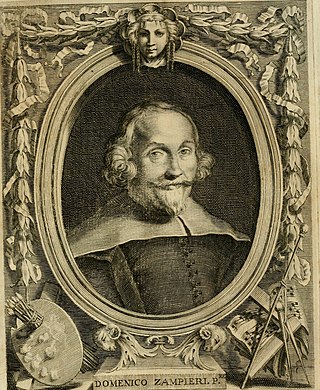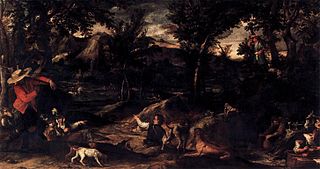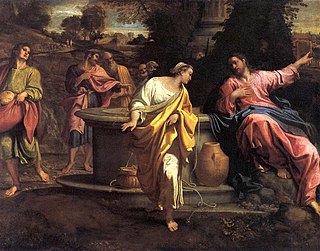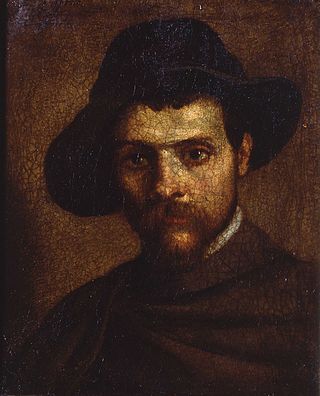
The Death of Saint Francis is the probable subject of two lost paintings by Annibale Carracci, both possibly dating to 1597-1598. One is known solely through a print and the other through a series of painted copies.

The Death of Saint Francis is the probable subject of two lost paintings by Annibale Carracci, both possibly dating to 1597-1598. One is known solely through a print and the other through a series of painted copies.
The first composition on the subject is recorded in a print after it by Gérard Audran, which is inscribed “Hannibal Carrache pinxit” ("Annibale Carracci painted [it]") [1] and a drawing after it by the Bolognese painter Aureliano Milani. No documents survive to date the work behind it or to elucidate its provenance and it is absent from all contemporary and early sources on Annibale. One autograph preparatory drawing for that painting does survive at the Royal Library in Windsor Castle, showing a reclining figure of the saint similar to that in the print. [2] [3] The drawing was probably for a now totally-lost painting by Carracci which Audran then reproduced. [3] One the reverse of the Royal Library drawing is a study of a nude young man, perhaps linked with plans for the Galleria Farnese. If so, this probably means the nude post-dates the Saint Francis study, with the latter produced about the same time as work began on the Galleria Farnese, that is, around 1597-1598. [3]
In his Felsina Pittrice (1678), Carlo Cesare Malvasia recorded "a most beautiful copperplate-painting [by Annibale Carracci] with a numb Saint Francis supported by an angel, with three cherubs in the air aiming at him" which he states was then in the Farnese collections at Palazzo del Giardino in Parma. That work was also mentioned in several 17th and 18th century inventories of the ducal collection in Parma. [4]
Art historians have identified three painted copies after that work, now in Sheffield Galleries and Museums, the Gemäldegalerie Alte Meister, Dresden and the Christ Church Picture Gallery in Oxford. [5] [6] However, all three are oil on panel not on copper and so - assuming Malvasia is correct about the original work's support - none of them can be the original. [4] The copies are high quality and have all been attributed to Annibale himself at some time in their lives [3] - Oxford and Sheffield still catalogue their versions as autograph works by Annibale. [7] [8] However, art historical consensus is now that all three works are copies by major names in the Emilian school - Denis Mahon suggested Ludovico Carracci for the Sheffield work and Bartolomeo Schedoni and Sisto Badalocchio have been suggested for that in Dresden. [3] Their quality and number both strongly suggest a particularly authoritative model for them probably painted by Annibale himself, now lost or unidentified. [4]

Agostino Carracci was an Italian painter, printmaker, tapestry designer, and art teacher. He was, together with his brother, Annibale Carracci, and cousin, Ludovico Carracci, one of the founders of the Accademia degli Incamminati in Bologna. Intended to devise alternatives to the Mannerist style favored in the preceding decades, this teaching academy helped propel painters of the School of Bologna to prominence.

Annibale Carracci was an Italian painter and instructor, active in Bologna and later in Rome. Along with his brother and cousin, Annibale was one of the progenitors, if not founders of a leading strand of the Baroque style, borrowing from styles from both north and south of their native city, and aspiring for a return to classical monumentality, but adding a more vital dynamism. Painters working under Annibale at the gallery of the Palazzo Farnese would be highly influential in Roman painting for decades.

Guido Reni was an Italian painter of the Baroque period, although his works showed a classical manner, similar to Simon Vouet, Nicolas Poussin, and Philippe de Champaigne. He painted primarily religious works, but also mythological and allegorical subjects. Active in Rome, Naples, and his native Bologna, he became the dominant figure in the Bolognese School that emerged under the influence of the Carracci.

Domenico Zampieri, known by the diminutive Domenichino after his shortness, was an Italian Baroque painter of the Bolognese School of painters.

Antonio Marziale Carracci was an Italian painter. He was the natural son of Agostino Carracci.

Giuseppe Maria Crespi, nicknamed Lo Spagnuolo, was an Italian late Baroque painter of the Bolognese School. His eclectic output includes religious paintings and portraits, but he is now most famous for his genre paintings.

Giovanni Lanfranco was an Italian painter of the Baroque period.

Bartolomeo Schedoni was an Italian early Baroque painter from Modena.

Hunting is a painting by Italian artist Annibale Carracci, painted before 1595 and given to Louis XIV by Prince Camillo Pamphili in 1665. It is currently held and exhibited at the Louvre in Paris.

The Carracci were a Bolognese family of artists that played an instrumental role in bringing forth the Baroque style in painting. Brothers Annibale (1560–1609) and Agostino (1557–1602) along with their cousin Ludovico (1555–1619) worked collaboratively. The Carracci family left their legacy in art theory by starting a school for artists in 1582. The school was called the Accademia degli Incamminati, and its main focus was to oppose and challenge Mannerist artistic practices and principles in order to create a renewed art of naturalism and expressive persuasion.

Pietà is a c. 1600 oil on canvas painting by Annibale Carracci, the earliest surviving work by him on the subject, which was commissioned by Odoardo Farnese. It moved from Rome to Parma to Naples as part of the Farnese collection and is now in the National Museum of Capodimonte in Naples. It is one of many 16th century Bolognese paintings dedicated to the theme of the Pietà, and it is counted among Carracci's masterpieces.

Christ in Glory with Saints and Odoardo Farnese or 'Christ in Glory with Odoardo Farnese and Saints Peter, John the Evangelist, Mary Magdalene, Hermenegild and Edward is a painting by Annibale Carracci. Placed in the Eremo di Camldoli either early in its life or straight after its creation, at the end of the 17th century Ferdinando II de' Medici moved it to the Galleria Palatina in Florence, where it still hangs.

Christ and the Samaritan Woman or The Woman at the Well is a 1593-1594 oil on canvas painting by Annibale Carracci, painted as part of the same scheme as the Palazzo Sampieri frescoes. Several years later he also produced a much smaller autograph copy with variations, now in the Museum of Fine Arts, Budapest.

Saint Roch Giving Alms is an oil on canvas painting by Annibale Carraci, commissioned between 1587 and 1588 by the Confraternity of San Rocco in Reggio Emilia, a body for whom he produced several works. His largest work on panel or canvas, it is the crowning achievement of his career before his move to Rome. Only completed in 1595, it is now in the Gemäldegalerie Alte Meister in Dresden, Germany.

Self-Portrait is a 1593 oil on canvas painting by Annibale Carracci, now in the Galleria Nazionale di Parma. It is dated 17 April 1593 on the top left of the canvas.

Madonna and Child with Saints is a 1588 oil on canvas painting by Annibale Carracci, now in the Gemäldegalerie Alte Meister in Dresden. Signed and dated by the artist, it is also known as Madonna and Child with Saints Francis, Matthew and John the Baptist, Madonna and Child Enthroned with Saint Matthew and the St Matthew Madonna.

Madonna and Child with Saints, Madonna and Child Enthroned with the Infant St John the Baptist, St John the Evangelist and Saint Catherine of Alexandria or the San Giorgio Madonna is a 1593 oil on canvas painting by Annibale Carracci, originally in the Landini chapel in the church of San Giorgio in Poggiale, Bologna. During the 19th century the conservation conditions there worsened and it was moved to the Accademia di Belle Arti for restoration, before being moved to its current home in the then-new Pinacoteca Nazionale di Bologna.. It is signed and dated "ANNI CARR FE MDXCIII".

Pietà with Saints Clare, Francis and Mary Magdalene is a 1585 oil on canvas painting by Annibale Carracci, now in the Galleria nazionale di Parma.

Pietà with Saint Francis and Saint Mary Magdalene is a 1602-1607 oil on canvas painting by Annibale Carraci. Now in the Louvre, it was looted from the Mattei family chapel in San Francesco a Ripa in Rome by Napoleon's troops in 1797 and was not returned at the end of the Napoleonic Wars.

Saint Margaret of Antioch is a 1599 oil on canvas painting by Annibale Carracci, showing Margaret of Antioch. It hangs in Santa Caterina dei Funari church in Rome.